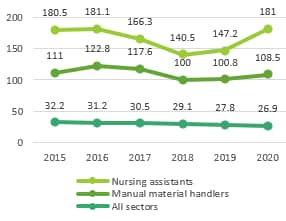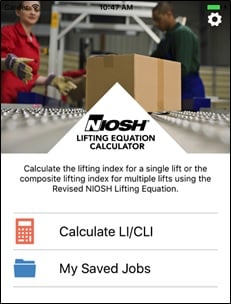Musculoskeletal Health Program
The National Institute for Occupational Safety and Health (NIOSH) Musculoskeletal Health Program works with partners in industry, labor, trade associations, professional organizations, and academia to prevent work-related musculoskeletal disorders (MSDs). MSDs are soft-tissue injuries caused by sudden or sustained exposure to repetitive motion, force, vibration, and awkward positions. Current objectives of the program are to:
- address risk factors for MSDs through improved assessment methods
- develop and evaluate the effectiveness of interventions
- use workers’ compensation data to better understand risk factors
- disseminate information on effective risk control methods and technologies.
- Surveillance: Locate and use unique sources of surveillance data (including surveys, insurance, and workers’ compensation data) to identify and prioritize areas that need MSD research to support under-served worker populations.
- Intervention Effectiveness: Develop and evaluate cost-effective interventions to prevent MSDs for high-risk jobs. Businesses with jobs that have high rates of MSDs such as manual material
- handlers and nursing assistants (see graph) may need scientifically proven programs, technologies, and strategies to control MSD risk factors.
- Communication: Share new information, control technologies, and prevention methods through a variety of formats tailored to the needs of specific worker and employer populations.
- Published an updated version of the applications manual for the revised NIOSH Lifting Equation. The update included editorial changes and improved graphics.
- Participated in an ISO technical committee to update ISO standard 11228-1 (manual lifting, lowering, and carrying). The standard adopted the suggested interpretation of lifting risk information described in a NIOSH paper.
- Developed a review document for assessing test methods of industrial exoskeletons. This review sheds light on choosing appropriate evaluation approaches and may help with decision-making during the development, evaluation, and application of industrial exoskeletons.
- Published a review paper to highlight the NIOSH hand-arm vibration research since 2000.
- Published workers’ compensation claim rates and costs for MSDs related to overexertion among construction workers.
- Published a study that summarizes the work-related biomechanical risk factors associated with the incidence of rotator cuff syndrome and highlights the importance of assessing combinations of exposure to forceful repetition and upper arm elevation when developing interventions.
- Disseminate information on best practices for preventing work-related MSDs at conferences and workshops in partnership with National Safety Council and AIHA.
- Develop a document on ergonomic engineering solutions for airport baggage handling.
- Promote awareness of the importance of preventing workplace MSDs using technologies, interventions, and best practices through the NIOSH Science Blog, eNews, and webinars.

Mention of any company or product does not constitute endorsement by the National Institute for Occupational Safety and Health, Centers for Disease Control and Prevention
The mission of the Musculoskeletal Health Program is to reduce work-related MSDs, such as carpal tunnel syndrome and low back pain. This snapshot shows recent accomplishments and upcoming work.

Source: U.S. Bureau of Labor Statistics.

NLE Calc App for estimating lifting risk is one of the top five most downloaded NIOSH mobile apps with 37,000 downloads since 2017.
To learn more, visit
www.cdc.gov/niosh/programs/msd/default.html
July 2022

